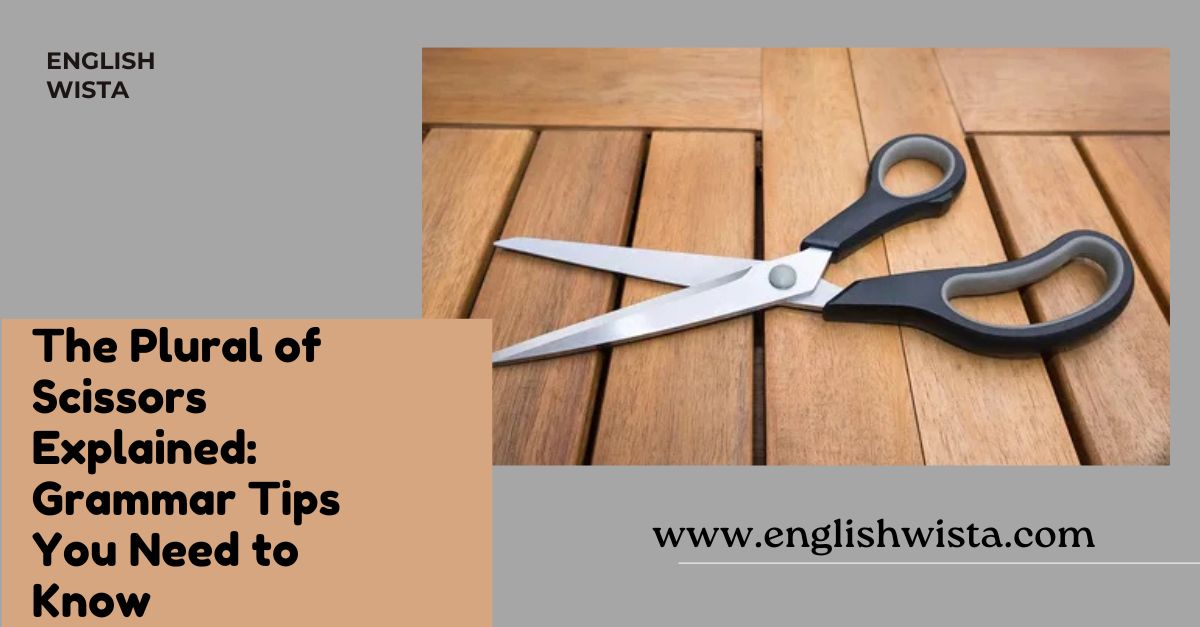Have you ever wondered about the word scissors? At first glance, it looks like it should already be plural. After all, it ends with an “s,” just like cats, dogs, or tables. But the more you think about it, the stranger it seems. Do we say a scissor or a pair of scissors? What about more than one do we say scissorses?
If you’ve ever felt confused by this word, you’re not alone. English has a few tricky nouns like this, and scissors is one of the most puzzling. Don’t worry we’re going to break it down step by step in simple, friendly language. By the end of this article, you’ll know exactly how to talk about scissors in both singular and plural situations.
Let’s take a closer look!
What Is the Plural of Scissors?
Here’s the quick and clear answer: The word scissors is already plural.
That means when you see scissors, you’re looking at a plural noun, just like glasses or pants. There is no form like scissor when you are talking about the tool we use to cut things.
For example:
- ✅ I need the scissors.
- ✅ These scissors are sharp.
- ❌ This scissor is sharp. (incorrect when referring to the tool)
So, the plural of scissors is simply scissors.
Is Scissors Singular or Plural?
This is where many learners get stuck. Scissors looks like it should be plural, but we often talk about it as if it were just one object. After all, one pair of scissors is a single tool, right?
Here’s how it works:
- Grammatically, scissors is plural. That means we usually use it with a plural verb.
- ✅ The scissors are on the table.
- But in meaning, one pair of scissors is a single object.
- ✅ I bought a pair of scissors.
This might feel strange, but English has a few nouns like this. We call them plural-only nouns or sometimes pluralia tantum (that’s just a fancy Latin term).
Other examples:
- pants (You don’t say a pant; you say a pair of pants.)
- glasses (You don’t say a glass if you mean eyeglasses; you say a pair of glasses.)
- tweezers
- binoculars
So scissors is in good company!
Why Do We Say “A Pair of Scissors”?
If scissors is plural, how do we talk about just one cutting tool? That’s when we use the phrase a pair of scissors.
Think of it this way: scissors are made of two blades joined together. That “two-ness” is built into the design of the word. That’s why English speakers think of scissors as plural, even when there’s only one tool on the table.
Examples:
- ✅ I need a pair of scissors to cut this paper.
- ✅ She bought three pairs of scissors for her classroom.
- ❌ She bought three scissors. (sounds wrong)
Notice that when you have more than one, you say pairs of scissors, not scissorses.
Can We Ever Use “Scissor” in Singular Form?
This is an excellent question, and the answer is yes, but only in special cases.
The word scissor exists as a verb:
- ✅ The tailor scissored the fabric neatly.
It also exists in some technical or descriptive uses, like in sports or mechanics:
- ✅ He used a scissor kick to score the goal.
- ✅ The device works with a scissor mechanism.
But in everyday English, when you’re talking about the tool, we almost never say a scissor. We stick with a pair of scissors.
A Simple Definition of Scissors
Let’s keep it very simple.
Scissors (noun): A cutting tool with two blades joined together, used for cutting paper, fabric, hair, and many other things.
That’s it. Short and sweet.
Example Sentences with Scissors
Examples are the best way to understand how to use this word. Let’s go through a few everyday situations:
- Talking about one tool
- I can’t find my pair of scissors.
- Could you pass me a pair of scissors, please?
- Talking about more than one
- The teacher has three pairs of scissors for the students.
- We bought several pairs of scissors for the art project.
- Using the word directly (plural)
- These scissors are very sharp.
- The scissors were lying on the desk.
Notice how we use are or were (plural verbs) with scissors.
Fun Fact: Where Does the Word Scissors Come From?
The word scissors has a long history. It comes from the Latin word cisoria, which meant “cutting instrument.” Over time, it passed through Old French and Middle English before becoming the word we use today.
Interestingly, for hundreds of years, people have treated scissors as a plural word. The idea is that because it has two blades, the tool feels like more than one thing. That’s why the word has kept its plural form.
How Do Other Languages Handle Scissors?
This is a fun comparison. In many languages, scissors are also treated as plural or dual (two-part) objects. For example:
- In French: les ciseaux (plural).
- In Spanish: las tijeras (plural).
- In Italian: le forbici (plural).
So English is not alone in treating scissors as a plural noun. Languages all around the world recognize that scissors are made of two blades, so they use a plural form.
Common Mistakes with Scissors
Let’s highlight a few mistakes learners often make, so you can avoid them:
- ❌ Saying a scissor when you mean the tool.
✅ Say a pair of scissors. - ❌ Saying scissorses when you mean more than one.
✅ Say pairs of scissors. - ❌ Using singular verbs.
✅ Correct: The scissors are on the desk. - ❌ Forgetting that scissors is always plural in form.
✅ Remember: Scissors look plural, and they are plural.
Other Nouns Like Scissors
We already mentioned a few, but let’s look at them again because this pattern is useful. English has a small set of nouns that are always plural in form, even when talking about one item.
Examples include:
- pants → one pair of pants, two pairs of pants
- shorts → one pair of shorts, three pairs of shorts
- glasses → one pair of glasses, four pairs of glasses
- binoculars → one pair of binoculars, two pairs of binoculars
- tongs
- pliers
- tweezers
All of these follow the same pattern as scissors. Once you learn one, the others make more sense!
A Memory Trick to Remember
Here’s a fun way to remember the rule. Think of the word scissors like pants. You would never say a pant when talking about clothing (unless you’re in the fashion industry, where “pant leg” is used). Instead, you say a pair of pants.
Scissors works the same way:
- Not a scissor → but a pair of scissors.
Easy, right?
Fun Extra: Collective Noun for Scissors
Did you know that English sometimes has special “collective nouns” for groups of things? For example, a group of birds is called a “flock.”
For scissors, there’s no official collective noun, but playful suggestions include:
- a snip of scissors
- a cut of scissors
- a sharpness of scissors
These aren’t standard, but they’re fun to imagine!
Quick Recap of the Key Points
Let’s sum everything up in a few simple points:
- The word scissors is plural.
- To talk about one tool, say a pair of scissors.
- To talk about more than one, say pairs of scissors.
- We use plural verbs with scissors (e.g., The scissors are…).
- The singular form scissor exists but is not used for the tool in everyday English.
- Other plural-only nouns include pants, glasses, binoculars, tweezers, and pliers.
Conclusion: Snipping Away the Confusion
Scissors may seem confusing at first, but once you see the pattern, it’s easy to understand. The word looks plural because it is plural. If you need to talk about one tool, just add the phrase a pair of in front.
So the next time you’re in class, at work, or in the kitchen and someone asks, “Where are the scissors?” you’ll know exactly why they said are and not is.
Language can sometimes feel like a puzzle, but the more pieces you put together, the clearer the picture becomes. And with scissors, you now have one less puzzle to worry about.
Now, grab your pair of scissors, and maybe cut some paper to celebrate you’ve snipped away the confusion!



